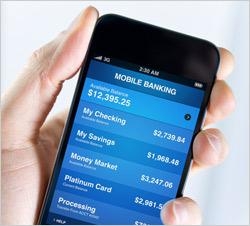Mobile Apps Make Banking Easier
- by Laurie Sullivan @lauriesullivan, September 10, 2013
 Some 40% of banking occurs on smartphones and tablets. While half of those consumers search for information, the remainder complete transactions like paying bills or transferring funds,
according to new research. Without a mobile app and Web site, brands lose the connection with customers.
Some 40% of banking occurs on smartphones and tablets. While half of those consumers search for information, the remainder complete transactions like paying bills or transferring funds,
according to new research. Without a mobile app and Web site, brands lose the connection with customers.
Apps make it easier to complete a transaction, while Web-based searches allow site visitors to find information, according to the xAd and Telmetrics Mobile Path to Purchase Study, Banking & Finance, released Tuesday. Companies across the board should apply this strategy.
For driving conversions in the banking and the finance industries, mobile researchers suggest developing a strategy that supports a mobile app and optimized site. Since fewer people download apps for banking compared with opening a Web browser and going directly to the site, they support fewer users, but have significantly higher engagement rates compared with mobile Web sites. With some overlap, the unique audience and reach for banking and finance in the U.S. for Android and iPhone in March was 45.5% for apps vs. 49.6% for browsers.
Consumers conduct frequent transactions on mobile devices, but many go online via their mobile device just looking for information. Some 24% look for contact information on smartphones vs. 25% on tablets. About 31% browse on smartphones vs. 40% on tablets. Eleven percent want to make a purchase, but still research on a smartphone, and 14% do these actions on a tablet. Smartphones and tablets attract consumers looking for a business to make a purchase, at 7% for both.
Consumers use both apps and Web-based search on banking and financial sites site, but the study suggests consumers use branded apps more to conduct transactions, and browsers to search for more general information.
On mobile devices, consumers will use apps more often to access banks like Chase, Bank of America, Capital One, Wells Fargo, and Mint.com. Mobile Web browsers are preferred when search for information or transacting business on PayPal, WSJ Digital, Chase, Chase Online, Reuters and Bank of America.
Visits to a bank via a mobile device are shorter than those from a PC. In fact, the average site visitors spend 5.5 minutes on a PC vs. 3.2 minutes from a smartphone and 3.0 minutes from a tablet. Smartphone banking activity mimics PC activity by hour, peaking during lunch and early evenings. Tablet use peaks in late afternoon at about 3 p.m. and fluctuates through to 11 p.m. when it depletes.
Younger users are more likely to notice an ad on smartphones, at 67%, vs. 65% on a tablet. Older banking and finance users are more likely to take actions based on an ad -- about 30% on tablets and 19% on smartphones -- for ages 45 to 54; and 20% and 16%, respectively, for ages 55 and older.
Overall, people who use banking and finance apps or Web-based browsing in the United States are slightly younger than average mobile users. For Android and iPhone users, females comprise half the demographics, with about 47 using applications and the remainder using browsers. Those ages 25 to 43 tend to use applications most -- at 27%, compared with Web browsers at 26%.
Most mobile and finance customers are Caucasian, bringing home between $50,000 and $99,000 annually.


